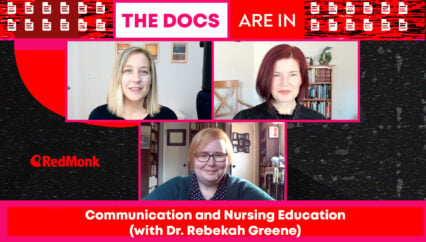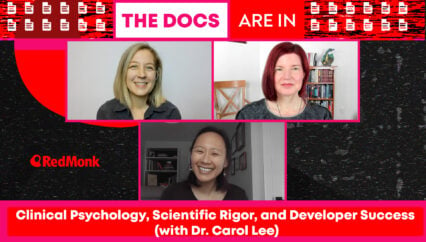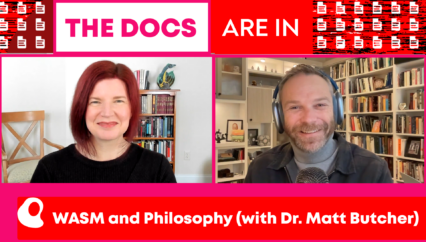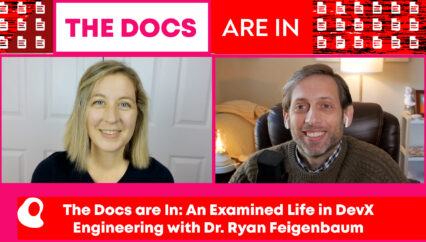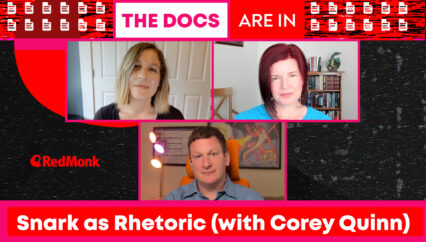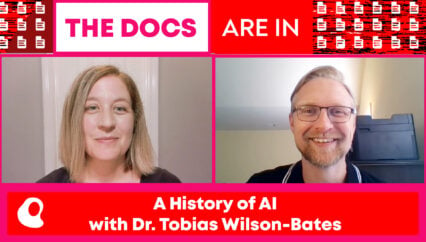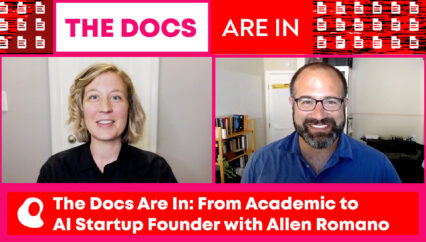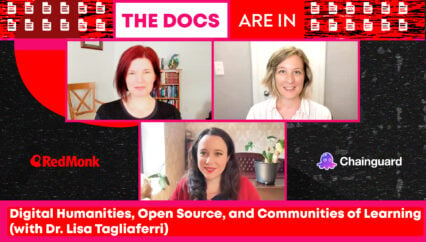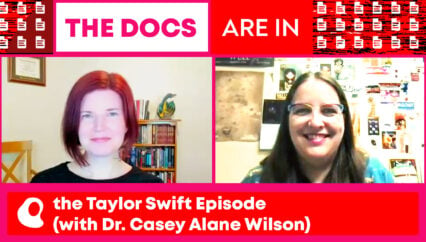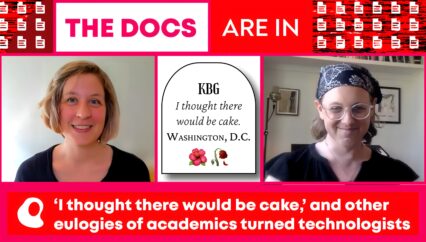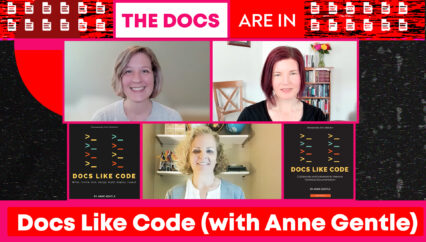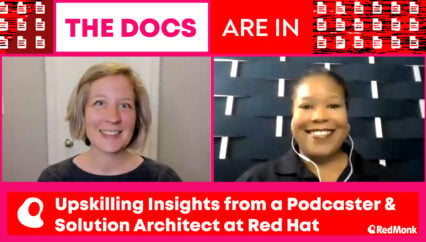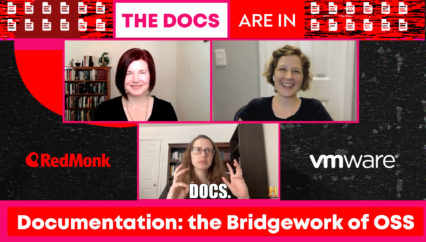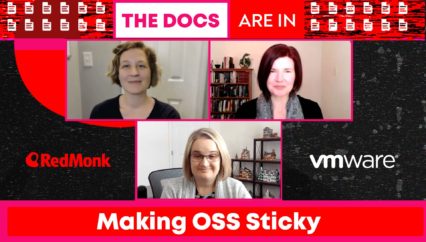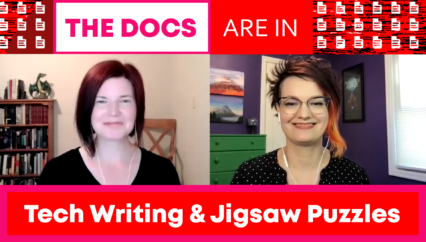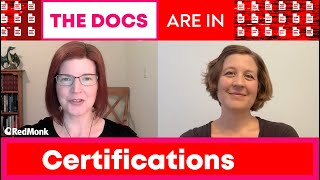This episode of the Docs are In features the most docs (and Georgia Tech references) yet, as Dr. Liz Hutter (Assistant Professor, University of Dayton) and Dr. Halcyon Lawrence (Associate Professor, Towson University) stop by to discuss some of the crucial work they are doing on the academic side of technical communication. Topics include a critique of the “grand narratives” common to the ways we talk about technical innovation (such as AI), a case study documenting Georgia Tech’s CS Tech Comm course sequence, and a little backstory into how both Liz and Halcyon landed on their current career paths.
This RedMonk video was not sponsored by any entity.
Related Resources
- Liz Hutter and Halcyon Lawrence. 2021. The Discourse of Technological Innovation: A New Domain for Accountability. In Proceedings of the 39th ACM International Conference on Design of Communication (SIGDOC ’21). Association for Computing Machinery, New York, NY, USA, 151–156.
- Learn about the ACM Special Interest Group on Design of Communication (SIGDOC)
- Program for the ACM SIGDOC 2021 conference
- Background on the CS Tech Comm course series at Georgia Tech
- Burnett, R. E., Frazee, A., Girard, A. K., Hutter, L., Lawrence, H., & Menagarishvili, O. (2022). Sustainable Collaboration: A Co-taught, Client-based Course Sequence Integrating Computer Science and Technical Communication. Programmatic Perspectives, 13(2), 11–51.
Rather listen to this conversation as a podcast?
Transcript
Kelly Fitzpatrick: Hello and welcome. This is Kelly Fitzpatrick with RedMonk here with another episode of the Docs are in. With me is my wonderful colleague, Dr. Kate Holterhoff. And today we have an extra docs laden episode of the Docs are In, in which we get to talk to multiple guests with doctorates about topics related to tech comm and documentation. With us today are Dr. Liz Hutter and Dr. Halcyon Lawrence. It’s worth noting that we were all Brittain Postdoctoral Fellows together at Georgia Tech in overlapping years, and both Halcyon and Liz were excellent mentors, especially to me, because I spent a lot of time doing tech comm. Thank you, Halcyon and Liz, for joining us. Before we get started with questions, can you tell us a little bit about who you are and what you do?
Dr. Liz Hutter: So, yes, I am currently an assistant professor at the University of Dayton, and I teach primarily technical communication courses. And part of that here also includes health communication. So I teach a lot of the health science pre-med pre PT students. Let’s see… I got my doctorate at the University of Minnesota and at that time I was in an English department. So my background is in literature, specifically in 19th century American literature. But I was also teaching writing as you all have — composition courses. But the Post Doc fellow at Georgia Tech really kind of pivoted me towards technical communication. And it was something I think I was doing and interested in but I didn’t have a name for it. So when I first started in business communication and then moved over into the working with the computer science students, I felt a real affinity for what was the kind of writing and the kinds of questions and the considerations we were asking. So I think tech comm found me in that respect and since then I have embraced it. And that’s how I, yeah — and I teach that now. I really have not taught literature in a very long time.
Dr. Halcyon Lawrence: Thanks Liz. So I am an associate professor at Towson University in the English Department, and this is my fifth year at Towson and it’s been really great. I teach what is called the service course. These are technical writing courses that are offered at the upper level to non-English majors. So the courses that I teach meet some core requirements or in some cases, some elective requirements for other majors in biology and physics and environmental science. We also have a Towson graduate professional writing program, and I also teach in that. So I teach courses in web design. One course in particular, I’m really excited about that I’ve been developing and refining is a course called Science and its Public Audience, and I teach courses in technical communication information design in that program as well. I’ll share a little bit more about my journey to tech comm from industry a little bit later. And I know you have a question about that, so I’ll share more about that later.
Kelly: I feel like both of you could’ve just been like, “I teach all the things.” We’re going to cover the list, the brief, probably the abbreviated list that you gave us.
Dr. Halcyon Lawrence: Especially in English departments, right? When you have — most English departments are pretty heavy laden with literature faculty, and then you have a handful of writing faculty. So it feels like you get to teach everything at some point in time.
Dr. Liz Hutter: And I would also add, I think that was the appeal for me of technical communication as a discipline, is that it really — you did do a lot of things, which again, I think is what I was drawn to. I think by its origins with engineering schools, it is interdisciplinary. Whereas sometimes with literature that feels like an add on, depending upon what direction you’re going in literary studies. But I just felt tech comm was just — because it did all the things, I could never get bored, and I was always learning new things and working with different kinds of subject matters and stakeholders.
Dr. Halcyon Lawrence: Liz, that’s a great point. There’s a class that I teach two sections of every semester for the last five years, and I still love it because it’s always changing. My students are always bringing something new and it just never gets dull for me.
Kate Holterhoff: All right. So think maybe this is a good time to try to situate this broader conversation in terms of our audience, because a lot of the Docs are In viewers were not teachers at any point, unlike the four of us. So could you situate what it’s like to teach technical communication for a lay audience? And maybe that would involve telling us a little bit about your path to tech comm, if there’s any details that might be relevant to that. And then how did you land at tech comm at your particular universities and what keeps you on the academic side of the house rather than defecting to industry like Kelly and I have done?
Dr. Halcyon Lawrence: I love that term defecting. I actually defected to academia, so I’ve moved between academia and industry. Soon after I left, I was teaching at the University of the West Indies as an adjunct faculty member for quite a few years and then I had an opportunity to go into IT. And so I worked in IT for about five years as a technical trainer and I loved it. I love the fact that it was one of those moments when I recognized that once I could understand something technical, I could teach to different types of audiences. And so that I had this ability to be able to translate really technical concepts to non-technical audiences or non-expert audiences. And so that really became an area of expertise for me. And then I think maybe around 2004 or 5, I got a call from the university, the Faculty of Engineering at the University of the West Indies, indicating that they had a couple of engineering courses that needed writing support. Our students were required to — and this was in the Department of Electrical and Computer Engineering. Students were required to do a final thesis, an undergrad thesis, and they just needed some better writing support. And I remember going into that classroom and designing a course and teaching, but I felt I was teaching on instinct. I didn’t have a term to describe what I was doing had no idea that was a form of technical communication. And one of the first conferences that I went to in England in 2006, I stepped into that conference and I was like, Oh, this is a field. And there are people who, you know, aren’t scratching their heads when I speak. I felt like I had just stepped into a community that I did not know that existed and that was the impetus for me coming to Chicago to pursue a PhD in technical communication and information design.
Dr. Halcyon Lawrence: And I did that at IIT and I completed that degree in 2013. So it’s been ten years. And so, I moved from industry into academia. There’s a part of me that misses working in industry, perhaps maybe as a consultant. Not, you know, full time at any one organization. I think my students benefit from me having a connection to industry and so am looking at ways of being able to to make those connections again. But one of the things that I help students do in the classroom is think about the ways in which they’re able to to become mediators of technical artifacts and technical writing as a way of communicating these technical ideas and concepts to non-expert audiences. And what we mean when we say non-expert — we don’t mean uneducated, we don’t mean ignorant, we don’t mean that they aren’t experts in other areas. But for this particular thing that they’re communicating, that user or that reader might not be considered to be an expert. We’ve been thinking a lot in the field of tech comm, particularly about how the role of the technical communicator is increasingly about supporting social justice, thinking about who doesn’t get to participate in these conversations for whom technology marginalizes and creates, you know, disproportionate outcomes. And so our students are engaged with more critical questions, not just about writing about technology, but about being able to critique technology in the first place and thinking more about a broad selection of users as they write and they communicate with them.
Kelly: I love — oh, there’s so much good stuff — I feel like we could talk about just that for the rest of the set. But the whole idea that technology is not some type of objective good and that there’s this apparent inherent way to read it or talk about it, that is the same for everybody. I think, Oh, my God, that’s so important.
Dr. Halcyon Lawrence: Yeah, it is. I mean, it’s the impetus for the people that I know you wanted us to chat a little bit about, so, I mean, maybe Liz can share a little bit about the background and the history of that work that we’ve been collaborating on for a couple of years now.
Dr. Liz Hutter: So before I do that, I think just another piece of my background is — it’s not really industry or it’s not the way I think of industry — but my path actually to grad school was interrupted, I guess. I was working in the sciences as a laboratory technician for a couple of years and then at another time, I went and got my masters and then I went into medical publishing for a couple of years. So at the time, again, I did the publishing before I did my PhD. But so when I went into graduate school, I think I already had a sense that there were — I wouldn’t have named them users at the time — but I certainly was aware of audience in ways that my graduate program, we weren’t thinking about when it came to our literary research. So I think for me, and this is, you know, transitioning into the tech classroom, the concept that I really latched onto was was how information had to be useful and relevant and applicable to particular kinds of situations. So even though now I work with the — or I teach the service tech comm course for the health science students. But for that, what that means is thinking about patients in their sociohistorical contexts. So, I think that adds a different dimension to the way my students are — you know, they’re in their organic chemistry classes and their anatomy classes. And so things are very factual and they’re memorizing concepts or processes. But so a tech comm class for me lately has become really a place to think more about even themselves as health professionals. Where do they come from? What do they value, what kind of information does their patient need? How do they explain it in a way, again, that relates to it?
Dr. Liz Hutter: So to bring that then back to that concept of the user, when I was at Georgia Tech and working with Halcyon, we were co-teaching the junior Capstone computer science course. It was at a point where students were pitching their project. So it was the first semester of a two semester sequence. I believe that was the stage. And they were conceptualizing what design project they wanted. And at that point we were noticing students were pitching things that really put the technology first, as in “we can do this, or wouldn’t it be great if we could do this” and then kind of work backwards and had to figure out why that technology that they were proposing was necessary or useful or desired by. And they weren’t thinking really at that stage, clearly or concretely enough about who this thing they could do, who it was for.
Dr. Liz Hutter: So it was at that point we started realizing there were some patterns in the way students were approaching their development. And this kind of led to then the four patterns that we talk about in our paper on the discourse of innovation. So one of the patterns we noticed is that students came from this deficit model — they weren’t responding to a problem. They sort of had to invent it in a way or overemphasize it. And so it kind of came out as, you know, the user lacked something — so this deficit model. And what they lacked, the technology they were developing was going to replace it and make all things better. So we noticed also a lot of essentialising in terms of the way they made their pitches as well. So, “everyone needs this or I’ll do this.” They sort of had these phrases of universality that didn’t really recognize the particular situations in which their, again, whatever they were pitching would be used or even the particularities of who their users would be. So those were two of the narratives or two of the patterns. So Halcyon, I think there were a couple of others. Do you want to–?
Dr. Halcyon Lawrence: Yeah, even as you’re talking, it’s taking me back to listening to some of those pitches. There were so many grand themes about what seemed to be really simple apps, you know, the “this app will change the world.” And Liz and I started getting curious about where those patterns were coming from. Like, where do students learn to talk about a smoothie app as having, you know, these revolutionary effects.
Kelly: The smoothie app that will save the world.
Dr. Liz Hutter: Yes. And change our lives all for the better.
Dr. Halcyon Lawrence: All for the better. Yeah. So aside from the deficit model, the user was always in need of saving because some deficit existed. Just to back up a little bit: what we did in this article which, the title of it is called The Discourse of Innovation: A New Domain for Accountability. What we started thinking about is the the way that technological innovations get described, that discourse around innovation really has to be held accountable. We started noticing very similar patterns about the way in which — we just mentioned our students — we’re talking about technology, but also in journalism as a technology journalist, we’re talking about these technologies in the same way. And so two of the other patterns that we noticed was the way in which pathos gets invoked through some compelling narrative that there’s always — the developer has this story. Often a story of one, maybe one person, a use case, that has just sort of shifted their trajectory on why this particular device needs to be created and make its way in the world. And so the simple use case then gets generalized to a greater need. But this idea of pathos that you get your audience to sympathize and to empathize with a problem was definitely one of the patterns that we saw.
Dr. Halcyon Lawrence: And then the other pattern that we saw was that some inalienable rights gets invoked. We didn’t always see this in the classroom, but as we started looking at a couple of case studies… we looked at the Theranos device. We looked at a device that was purported to read one’s mind. And we looked at a case of a SignAloud glove. In all of these cases, we saw developers couching the problem that this device would restore a user’s inalienable right: the right to communicate — the right to access to health care. And what was problematic, of course, about that is that when these rights get invoked, we don’t enter into conversation about what’s really the problem? Why don’t people have access to universal health care? What are the socio historical political contexts that are depriving people in the first place? So it was really striking with the Theranos case where Elizabeth Holmes would suggest that this device, the Edison, would fix that problem, when we knew that it’s far more than just the prick of the finger and getting multiple tests done by one drop of blood. So that was another pattern that we noticed.
Dr. Halcyon Lawrence: And I think the last pattern was that there was always sort of a disproportionate scale of the impact with the simplicity of the solution. So, you know, by the click of a button — the most recent one that Liz and I have been looking at is Sanas AI that allows a user to click a button and their call center representatives can click a button and they no longer are heard using their native accents, but they can sound American or they can sound White. So at the click of a button, even if you go to Sanas AI’s website, you’ll see magic on their website. So there was always this very simple solution that would benefit the world, benefit millions, benefit thousands, whole communities. Which is a really attractive proposition, right? And so we started looking at the ways in which those ideas got replicated across a number of technological devices. And the paper that we’ve written asks readers to start thinking about why is it the way that it is, and suggesting that given that we are now at a watershed moment of holding technology companies accountable for what they put out into the world, we also have to hold a discourse around those technologies accountable as well. I think that sums it up.
Kelly: I think that sums it up — delightfully is probably the term — the term that I would use. And you know, as I was rereading the paper — and we’ll put a link to the paper in the show notes so people can go and check it out — discourse is something that, since I’ve moved into the tech industry, is not a term that we use as often as we do in, say, academia, especially in English departments. But here I feel like it’s one that is so apt, just the patterns that you’re describing where you have folks who are promoting these solutions, that are addressing just the symptoms of things that are deeper problems or that are positioning entire populations as somehow having a problem that needs to be solved or in a way that they need to be saved. And like, yes, discourse is exactly the type of word or the discourse of discourse is, I think, what is very appropriate here.
Dr. Halcyon Lawrence: Absolutely. Go ahead, Liz.
Dr. Liz Hutter: Oh, just a small anecdote. This kind of talks about to where students learn this, but I gave a version — this was like over a year ago or soon after we did the SIGDOC presentation — I gave a version of that presentation to my department as like one of our lunch hour sessions. And it landed a little bit differently than the way I think we’re talking about it, because what that audience responded to was like, oh my gosh, we teach that in our, you know, English 100 or 200 class. And so they were kind of like, wait, we’re doing this. But you’re saying also it’s become, you know, it can be exploited almost or misapplied. And manipulative, too. It can mask a lot of the complexities that, in the case of the developers, the complexity of what goes into that development and the assumptions that they’re making. So I appreciated their reaction too, because I do think we teach students and again, in our composition classes, how do you attract, how do you engage your audience? Well, you tell a compelling story. We teach those.
Dr. Liz Hutter: So I think there’s something that this discourse is almost just regularized in the way our classrooms are set up, like the way we’re taught to write, for example. So I think the tech comm side of things are — I mean it’s changed the way I even think about when I teach the composition classes. I’m now very careful about how I’m presenting these strategies to students. And again, I think it comes back to the context — in which they are writing or speaking or developing, but really getting students to think about the implications. So if you say this, why are you saying that? Who in your audience will relate to that? Who won’t and why? And and I think that ties back to one of the implications, I think that we had for our our paper, too, which is if you don’t think about the implications, some of the the biases, the implicit biases, the injustices, the exclusions just get replicated.
Dr. Halcyon Lawrence: Yeah. And that brings up one of the points that we echo. Mar Hicks in their work talks about the fact that if a technology is reinscribing bias, it cannot be described as being revolutionary. And yet that is the discourse that we see quite often when technology journalists are writing about technology, this revolutionary thing. And yet we’re seeing that communities continue to get marginalized. They don’t get pulled into the –their lives aren’t, you know, getting any better because of this technology. And so we have to really — the discourse itself continues to reinscribe that bias. I was going to say that one of the other things, one of the ways that this has changed how I teach technical communication is I have asked my students to think a lot more about their roles as power brokers, as communicators, that they hold this really important, powerful role in translating and communicating. They get to decide what’s important. They get to decide what an audience or a user hears about this technology. And so they have they have to examine their own positionality to the artifact.
Dr. Halcyon Lawrence: What are the assumptions, what are the experiences? But they also have to examine their own positionality with regard to the users. What kind of power do they hold, what kinds of experiences — their geographic location, their gender orientation, and how do all of those identity markers begin to bear on what they produce as technical communicators? What gets talked about? What doesn’t get talked about? What gets critiqued? One of the things that we noticed, for example, we were looking at the Chat GPT coverage, news coverage, very different. Journalists have offered very balanced views about that and we were even speculating if in part because of the very nature of what Chat GPT does, there’s sort of this very personal impact on journalists. And so they’re able to appreciate, you know, why it’s problematic in a way that perhaps we’ve seen, you know, other kinds of technology being described as revolutionary. And so journalists play a really important part in that. But that process, we have to we have to hold that language accountable.
Kelly: Right now, I’m thinking in my mind and hoping that students who have gone through both of your courses end up not only in tech journalism, but maybe in marketing or something like that. Because, you know, talking about the rhetoric and the way these things are spoken about in journalism is one thing. But often journalism, the way we think, is so much affected by the marketing and the way things are messaged from vendors and creators themselves. So there’s so much goodness going on there. But Kate, you had a question in going back to where this paper came from and the origins of that.
Kate: Yeah, I think it’s important because we’ve really dug into all this nuance with context, especially when it comes to where our students are coming from with your own background. And I think maybe it’s important for us to think about how we’re ingesting this sort of critical work here. So I guess this research was initially presented at the 2021 conference for the Special Interest Group on Design of Communication of the Association for Computing Machinery, or ACM SIGDOC, which, Hal, I know you were the program co-chair, and it’s published as part of these proceedings. So for folks who aren’t familiar with what is SIGDOC, what is this audience like? Like, how can we better understand how folks are understanding the type of research that is absolutely important and should be more widely read? You know, how are they understanding this? What is this sort of discourse community look like?
Dr. Halcyon Lawrence: Thanks for that question, Kate. I was thinking about your listeners, your potential listeners, and I’m sure many of them are familiar with a number of other things connected to ACM. So, the SIGDOC in particular stands for Special Interest Group on the Design of Communication. It actually is the smallest SIG in ACM. I think we’re about 300 members. I’ve recently joined the committee and so it’s been interesting seeing how such a small committee works within a larger organization like ACM. I mean, some SIGs have tens of thousands of members. What’s unique about SIGDOC, of course — and Liz and I were laughing because we’re introducing yet another doc here today. It’s the design of communication. So this particular Sig is interested in how communication gets designed. We’re interested in for whom it gets designed, — the kinds of choices that we make around the design of communicating about technical artifacts. What’s also really great about this thing is that the members come both from industry and academia. And I know that for many disciplines there’s always a concern about how you bridge that academic and professional divide not just for building a bridge for students, but how do we benefit from the research that happens in academia and the kind of research that happens in industry and making those kinds of findings publishable and accessible to broader audiences. And so Sig is great in that it does that. There is a flagship publication called Community Communication Design Quarterly that I think yeah, it comes out four times a year. And then we have this annual conference, the year that Liz and I — the year that I co-chaired was a pandemic year. So we actually had it online —
Dr. Liz Hutter: I should say, not me, Liz.
Dr. Halcyon Lawrence: Oh, sorry. Yes. I had a co-chair, Liz Lane, who is at the University of Memphis. And it was also the year that Liz Hutter and I wrote this article because the theme that year was accountability. We were coming out of this period of COVID. We thought, Liz Lane and I thought, that this would be a great opportunity for us as a community of researchers to stop and take stock. And we were interested in having researchers think about accountability before we moved on to other things. And so Liz and I — Liz Hutter and I — who had been thinking about this discourse and language around technology thought this would be a great place to finally write this paper. And it’s a paper that we’re really proud of as well. It holds up. And unfortunately, I think it’s going to hold up for quite a while.
Kelly: It does. And just rereading it to prepare for this, I’m like, this is so relevant, especially with everything going on with generative AI and the way — we’ve talked a little bit about that — but very timely and a paper that I think will continue to be to be timely. We are getting close to time, and there’s one more question I have for for both of you. So, you know, Liz and Halcyon, another collaborative piece that you’ve contributed to with some of our other former colleagues from Georgia Tech was a case study in the December 2022 issue of Programmatic Perspectives — and again, we’ll put a link to that in the show notes — on Georgia Tech’s Computer Science, Junior Design and Tech comm sequence, which is the program that we’ve all taught in. What was it like looking back at your time in that program and kind of revisiting it and seeing how it has evolved over the years?
Dr. Liz Hutter: Yeah. It’s humbling and impressive, I think. Hal and I, our moment in the program kind of came, I think, at a pivotal moment when the program really was moving away from — I don’t know, I forget, we probably had a word for it — but kind of where tech comm was attached with computer science, we were moving away from that to something where the integration of the technical communication and the computer science was much stronger to the point where it was hard to separate maybe what was tech comm and what was computer science. And so in that moment we weren’t able — or at the time we couldn’t see where we were going. But looking back on it, I think it was a critical moment because everything — by moving towards a more integrated model for the teaching, or the clients, everything became integrated. It really is what allowed, I think, the program to grow. So it’s looking back — it’s humbling because yeah, that was six, seven years ago. It’s gone quite far. So writing that article, I was amazed at, or I appreciated — amazed, but I also appreciated really the complexity of participants who were part of that program. So it wasn’t just the instructors, it was the clients, it was administrators in both departments or both colleges. There was even like legal — Now we have a legal component too. So it really is impressive. And just the breadth of that and the kinds of collaboration. I mean collaboration can be kind of an overused word, but collaboration at every step of the way, always negotiating something: a priority, a value, a process of doing something. So yeah, I think that comes out over the course of the program, over the program’s history, is just the maintaining that and sustaining that complexity.
Dr. Halcyon Lawrence: Yeah. Thanks for that, Liz. I’m happy for the question. Just the opportunity to be able to reflect on that reflection process that we did. And it occurred to me that looking back at ten years of a program and writing about it is another form of documentation that we don’t often think about and that there is value in documenting experiences along with documenting processes and standards and syntax. And the reason I think there is value in documenting experience is that we recognize that experiences happen within a particular context, particular social context, historical context, and it explains the kinds of decisions that we make around design that we face at particular points in the program, real constraints. We couldn’t do certain things and therefore we made certain kinds of choices. And I think documenting that becomes important because there is an implication for replicability. And Liz and I were talking about this, you know, that somebody can pick up that kind of article and think, Oh, great, I’d love to do this in my own institution. But this might not work in the way that I see it documented here.
Dr. Halcyon Lawrence: And I wonder if for your listeners who are also developers, if they may be attracted to that idea of moving beyond documentation that is just about code and thinking about documentation that also acknowledges sort of the context in which these decisions about their own applications get made. I think that’s an important thing to consider. So it was good, it was messy. I mean, it was what, 6 or 7 of us who were writing the paper. And so there was this constant triangulating that was going on. And it’s messy because it’s not something that’s over. It’s still in flux and still changing. People remember things differently in terms of why certain things happen the way that they did. And so it was a really messy, wonderful experience in that context to be able to to say, here’s what happened, but also here’s why it happened. The way in which it happened I think is valuable.
Kate: It has been an absolute privilege to catch up with Halcyon and Liz talking about their research, and I’m looking forward to studying some of these reports and articles that you’ve written with a new eye, a more educated lens. So want to thank you and please be sure to join us for future Docs are In where we talk all things documentation, doctorates, upskilling. And with that, the docs are out.
